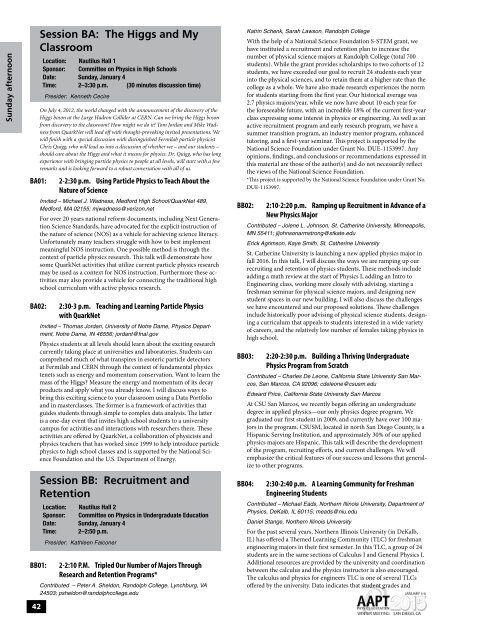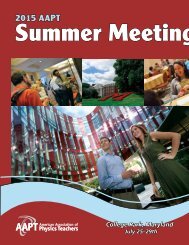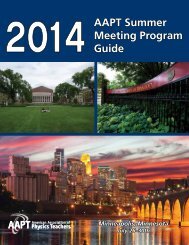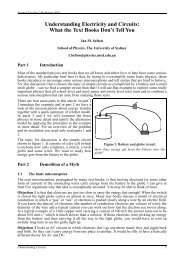final-program-12-23-14-3
final-program-12-23-14-3
final-program-12-23-14-3
You also want an ePaper? Increase the reach of your titles
YUMPU automatically turns print PDFs into web optimized ePapers that Google loves.
Sunday afternoon<br />
42<br />
Session BA: The Higgs and My<br />
Classroom<br />
Location: Nautilus Hall 1<br />
Sponsor: Committee on Physics in High Schools<br />
Date: Sunday, January 4<br />
Time: 2–3:30 p.m. (30 minutes discussion time)<br />
Presider: Kenneth Cecire<br />
On July 4, 20<strong>12</strong>, the world changed with the announcement of the discovery of the<br />
Higgs boson at the Large Hadron Collider at CERN. Can we bring the Higgs boson<br />
from discovery to the classroom How might we do it Tom Jordan and Mike Wadness<br />
from QuarkNet will lead off with thought-provoking invited presentations. We<br />
will finish with a special discussion with distinguished Fermilab particle physicist<br />
Chris Quigg, who will lead us into a discussion of whether we – and our students –<br />
should care about the Higgs and what it means for physics. Dr. Quigg, who has long<br />
experience with bringing particle physics to people at all levels, will start with a few<br />
remarks and is looking forward to a robust conversation with all of us.<br />
BA01: 2-2:30 p.m. Using Particle Physics to Teach About the<br />
Nature of Science<br />
Invited – Michael J. Wadness, Medford High School/QuarkNet 489,<br />
Medford, MA 02155; mjwadness@verizon.net<br />
For over 20 years national reform documents, including Next Generation<br />
Science Standards, have advocated for the explicit instruction of<br />
the nature of science (NOS) as a vehicle for achieving science literacy.<br />
Unfortunately many teachers struggle with how to best implement<br />
meaningful NOS instruction. One possible method is through the<br />
context of particle physics research. This talk will demonstrate how<br />
some QuarkNet activities that utilize current particle physics research<br />
may be used as a context for NOS instruction. Furthermore these activities<br />
may also provide a vehicle for connecting the traditional high<br />
school curriculum with active physics research.<br />
BA02:<br />
2:30-3 p.m. Teaching and Learning Particle Physics<br />
with QuarkNet<br />
Invited – Thomas Jordan, University of Notre Dame, Physics Department,<br />
Notre Dame, IN 46556; jordant@fnal.gov<br />
Physics students at all levels should learn about the exciting research<br />
currently taking place at universities and laboratories. Students can<br />
comprehend much of what transpires in esoteric particle detectors<br />
at Fermilab and CERN through the context of fundamental physics<br />
tenets such as energy and momentum conservation. Want to learn the<br />
mass of the Higgs Measure the energy and momentum of its decay<br />
products and apply what you already know. I will discuss ways to<br />
bring this exciting science to your classroom using a Data Portfolio<br />
and in masterclasses. The former is a framework of activities that<br />
guides students through simple to complex data analysis. The latter<br />
is a one-day event that invites high school students to a university<br />
campus for activities and interactions with researchers there. These<br />
activities are offered by QuarkNet, a collaboration of physicists and<br />
physics teachers that has worked since 1999 to help introduce particle<br />
physics to high school classes and is supported by the National Science<br />
Foundation and the U.S. Department of Energy.<br />
Session BB: Recruitment and<br />
Retention<br />
BB01:<br />
Location: Nautilus Hall 2<br />
Sponsor: Committee on Physics in Undergraduate Education<br />
Date: Sunday, January 4<br />
Time: 2–2:50 p.m.<br />
Presider: Kathleen Falconer<br />
2-2:10 P.M. Tripled Our Number of Majors Through<br />
Research and Retention Programs*<br />
Contributed – Peter A. Sheldon, Randolph College, Lynchburg, VA<br />
24503; psheldon@randolphcollege.edu<br />
Katrin Schenk, Sarah Lawson, Randolph College<br />
With the help of a National Science Foundation S-STEM grant, we<br />
have instituted a recruitment and retention plan to increase the<br />
number of physical science majors at Randolph College (total 700<br />
students). While the grant provides scholarships to two cohorts of <strong>12</strong><br />
students, we have exceeded our goal to recruit 24 students each year<br />
into the physical sciences, and to retain them at a higher rate than the<br />
college as a whole. We have also made research experiences the norm<br />
for students starting from the first year. Our historical average was<br />
2.7 physics majors/year, while we now have about 10 each year for<br />
the foreseeable future, with an incredible 18% of the current first-year<br />
class expressing some interest in physics or engineering. As well as an<br />
active recruitment <strong>program</strong> and early research <strong>program</strong>, we have a<br />
summer transition <strong>program</strong>, an industry mentor <strong>program</strong>, enhanced<br />
tutoring, and a first-year seminar. This project is supported by the<br />
National Science Foundation under Grant No. DUE-1153997. Any<br />
opinions, findings, and conclusions or recommendations expressed in<br />
this material are those of the author(s) and do not necessarily reflect<br />
the views of the National Science Foundation.<br />
*This project is supported by the National Science Foundation under Grant No.<br />
DUE-1153997.<br />
BB02:<br />
2:10-2:20 p.m. Ramping up Recruitment in Advance of a<br />
New Physics Major<br />
Contributed – Jolene L. Johnson, St. Catherine University, Minneapolis,<br />
MN 55411; jljohnsonarmstrong@stkate.edu<br />
Erick Agrimson, Kaye Smith, St. Catherine University<br />
St. Catherine University is launching a new applied physics major in<br />
fall 2016. In this talk, I will discuss the ways we are ramping up our<br />
recruiting and retention of physics students. These methods include<br />
adding a math review at the start of Physics I, adding an Intro to<br />
Engineering class, working more closely with advising, starting a<br />
freshman seminar for physical science majors, and designing new<br />
student spaces in our new building. I will also discuss the challenges<br />
we have encountered and our proposed solutions. These challenges<br />
include historically poor advising of physical science students, designing<br />
a curriculum that appeals to students interested in a wide variety<br />
of careers, and the relatively low number of females taking physics in<br />
high school.<br />
BB03:<br />
2:20-2:30 p.m. Building a Thriving Undergraduate<br />
Physics Program from Scratch<br />
Contributed – Charles De Leone, California State University San Marcos,<br />
San Marcos, CA 92096; cdeleone@csusm.edu<br />
Edward Price, California State University San Marcos<br />
At CSU San Marcos, we recently began offering an undergraduate<br />
degree in applied physics—our only physics degree <strong>program</strong>. We<br />
graduated our first student in 2009, and currently have over 100 majors<br />
in the <strong>program</strong>. CSUSM, located in north San Diego County, is a<br />
Hispanic Serving Institution, and approximately 30% of our applied<br />
physics majors are Hispanic. This talk will describe the development<br />
of the <strong>program</strong>, recruiting efforts, and current challenges. We will<br />
emphasize the critical features of our success and lessons that generalize<br />
to other <strong>program</strong>s.<br />
BB04:<br />
2:30-2:40 p.m. A Learning Community for Freshman<br />
Engineering Students<br />
Contributed – Michael Eads, Northern Illinois University, Department of<br />
Physics, DeKalb, IL 60115; meads@niu.edu<br />
Daniel Stange, Northern Illinois University<br />
For the past several years, Northern Illinois University (in DeKalb,<br />
IL) has offered a Themed Learning Community (TLC) for freshman<br />
engineering majors in their first semester. In this TLC, a group of 24<br />
students are in the same sections of Calculus I and General Physics I.<br />
Additional resources are provided by the university and coordination<br />
between the calculus and the physics instructor is also encouraged.<br />
The calculus and physics for engineers TLC is one of several TLCs<br />
offered by the university. Data indicates that student grades and






